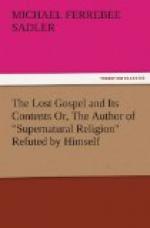And yet there can be no doubt but that the passage is open to this insurmountable objection, that if Josephus had written it he would have professed himself a Christian, or a man of incredible inconsistency. Setting aside the difficulty connected with the acknowledgment of Jesus as the Christ, inasmuch as this name was frequently given to Him by those who did not believe in Him, yet how could Josephus state that His Resurrection was predicted by the prophets of his nation, and continue in appearance an unbeliever?
But, whether genuine or not, this passage is decisive as to the impossibility of what is styled an independent testimony to our Lord: “He that is not with Me is against Me.” The facts of our Lord’s chief miracles and Resurrection were such, that the nearer men lived to the time the more impossible it would have been for them to have suspended their judgment.
So that, instead of having the witness of men who, by their prudent suspension of judgment, betrayed their lurking unbelief, we have the testimony of men who, by their surrender of themselves, soul and body, evinced their undoubting faith in a matter in which there could be really no middle opinion.
SECTION XXV.
DATE OF TESTIMONY.
One point remains—the time to which the testimony to our Lord’s miracles reaches back. Can it be reasonably said to reach to within fifty years of His Death, or to within twenty, or even nearer?
The author of “Supernatural Religion” asserts that it was not contemporaneous or anything like it. In fact, one might infer from his book that the miracles of Christ were not heard of till say a century, or three quarters of a century, after His time, for he says, “they were never heard of out of Palestine until long after the events are said to have occurred.” [185:1] (P. 192.)
In such a case, “long after” is very indefinite. It may be a century, or three quarters of a century, or perhaps half a century. It cannot be less, for every generation contains a considerable number of persons whose memories reach back for forty or fifty years. In a place of 3,000 inhabitants, in which I am now writing, there are above fifty persons who can perfectly remember all that took place in 1830. There are some whose memories reach to twenty years earlier. Now let the reader try and imagine, if he can, the possibility of ascribing a number of remarkable acts—we will not say miraculous ones—to some one who died in 1830, and assuming also that these events were the basis of a society which had commenced with his death, and was now making way, and that the chief design of the society was to make known or keep up the memory of these events, and that there had been a literature written between the present time and the time of the said man’s death, every line of which had been written on the assumption that the events in question were true, and




